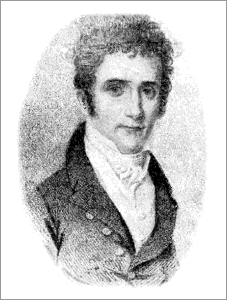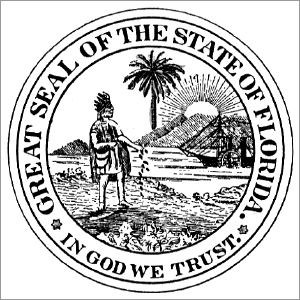| Home > Floripedia > Florida Becomes a State | |
Florida Becomes a State
A History of Florida1904
Admitted as a State. After the end of the Indian war, many persons came to make their homes in Florida, towns grew, and people began to think that it was time for the Territory to become a State. They wanted to be able to elect their governor, to send senators and representatives to Congress, to take part in electing the President, and to enjoy many other privileges not allowed a Territory.
Some thought Florida should be divided into two States, East Florida and West Florida, while others thought it should not be divided. Finally Congress agreed that Florida should come into the Union as one State, and the bill was signed by President Tyler, March 3, 1845.

Governor John BranchGovernor John Branch. The governor of Florida at that time was John Branch of North Carolina. Few men have held more responsible positions or have been more esteemed than he. For six years he was a member of the Senate of North Carolina, and was afterwards made governor of that State. After serving as governor, he was sent to the United States Senate, and just after he had been elected a second time, Jackson made him secretary of the navy in his Cabinet. Later he was elected member of Congress, then again a member of the State Senate, and was appointed governor of Florida in 1844.
What occasion marked a great impetus in the growth of Florida? What proposition was agitated preliminary to seeking admission as a State? How and when was Florida admitted?
First Election, 1845. Governor Branch fixed the 26th of May, 1845, as the date for electing a governor and other State officers. When the votes were counted, it was found that William D. Moseley was elected, and so he became the first governor of the State of Florida.
In 1838 a convention had met at St. Joseph, which was then one of the most important towns of the State, but has now entirely disappeared, and had framed a constitution for the Territory. This was adopted as the State constitution, and was the basic law of the State until 1861.
Who was then governor? Tell of his former distinctions. In what year did he become governor? When was the first election held for the State of Florida? Who was elected governor?
Governor Moseley. Like Eaton and Branch the new governor was a native of North Carolina and had been educated at Chapel Hill, where he graduated in the class with James K. Polk. Before he came to Florida he had been a member of the Senate of North Carolina for nine years.
Progress—Completion of Capitol. While he was governor, much public land was sold, and many persons came to make their homes in the State. Much interest seems to have been felt in education, and the governor in his message to the Legislature, urged the establishment of schools and seminaries, especially the common schools "that should bring instruction to every man's door." It was in 1845 that the capitol, the corner stone of which was laid twenty years before, was completed.
Indian Outbreak. There were now several hundred Indians in the State, one hundred and fifty of whom could bear arms. Though so few in numbers, it was remembered that in the Seminole War, great harm had been done by small bands when our forces were in the field. People, especially those near the reservation, did not feel that life or property was safe, for the Indians did not confine themselves to their limits, but would make excursions into the neighboring country, sometimes as far as a hundred miles. In 1849 and 1857 there were Indian outbreaks, but they were soon put down by the State troops.
What were the important features of Gov. Moseley's administration?
Governor Brown. Our next governor was Thomas Brown. He was a native of Virginia, but had lived in Florida for many years, his upright life and kind heart winning for him many friends in private and public life. He was much interested in the establishment of schools, and while he was governor complained that Florida was making slow progress.
Governor Broome. At the next election James E. Broome was chosen governor. In Broome's administration there was another Indian outbreak, more serious than the last, but this too was quelled by the State troops. Governor Broome was succeeded by Madison Starke Perry, the latter part of whose term was filled with political excitement.
The Rupture of the Nation. When our government was formed after the Revolution, it was generally believed that any State had the right to withdraw from the Union as freely as it had entered. The New England States had threatened more than once to use this right. The people of the South still believed that this right was their only protection against injustice. They felt that they had been treated unjustly by the government in not being allowed to take their slaves into new Territories, and when Lincoln, who had declared that the Union could not exist "half slave and half free," was elected President, they believed that the time had come to separate their Union and form their own government.
What trouble was there in 1849? Who succeeded Moseley? Who was the third State governor? What was the chief event in Broome's administration? What was the general belief regarding States' rights?
Secession Convention. This was not an unexpected trouble, but bad been long foreseen. Governor Moseley had years before spoken of "the clouds over the Southern horizon," and had said that dear as the Union was, the people of Florida ought never to give up their rights. In 1859 the Legislature declared that Florida would stand by the other Southern States if their rights were in danger.

Seal of FloridaIn November of the next year Governor Perry recommended to the Legislature the withdrawal of the State from the Union, and called a convention for that purpose to meet at Tallahassee, January 3, 1861.
Ordinance Adopted. In this convention were many whose names afterwards became distinguished. There were Davis, Ward, Lamar, Patton, Anderson, Finnegan, Daniel, and others of great zeal and talent. Bishop Rutledge opened the convention with prayer. There was the greatest interest, and the capital was crowded every hour the convention was in session. On January 10 the vote was taken and the ordinance of secession was passed. It declared that Florida withdrew herself from the Union and was an independent nation.
Excitement. There was the wildest excitement. Amid shouts and cheers men embraced each other and cried that the day of liberty had come. When the Declaration of Independence was signed, the Liberty Bell was rung.
What was one of the causes of the resort to secession? What shows that this action had been expected for some years? Give the date of the convention and some of the representative names on its Membership roll.
Florida had no liberty bell, but Madame Murat was invited to fire the cannon in honor of the occasion. some. There were some, however, who felt no gladness; some still loved the Union and honored the old flag, and their hearts were sad, and tears filled their eyes.
Source:
Excerpt from Part Two, Chapter 11, "How Florida became a State, and how she withdrew from the Union" A History of Florida, 1904. Next Section; Table of Contents.
| Home > Floripedia > Florida Becomes a State |
Exploring
Florida: A Social Studies Resource for Students and Teachers
Produced by the Florida Center for Instructional
Technology,
College of Education, University of South Florida © 2005.